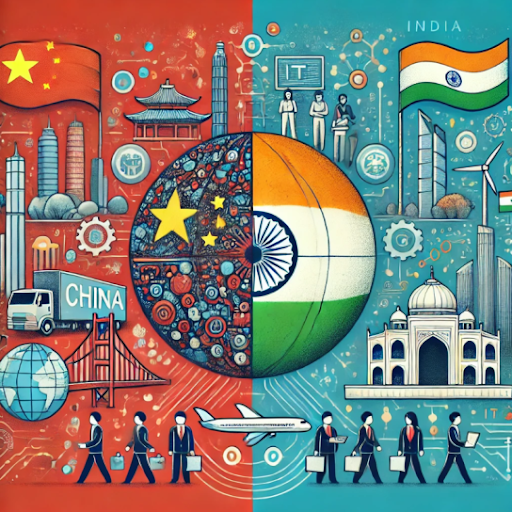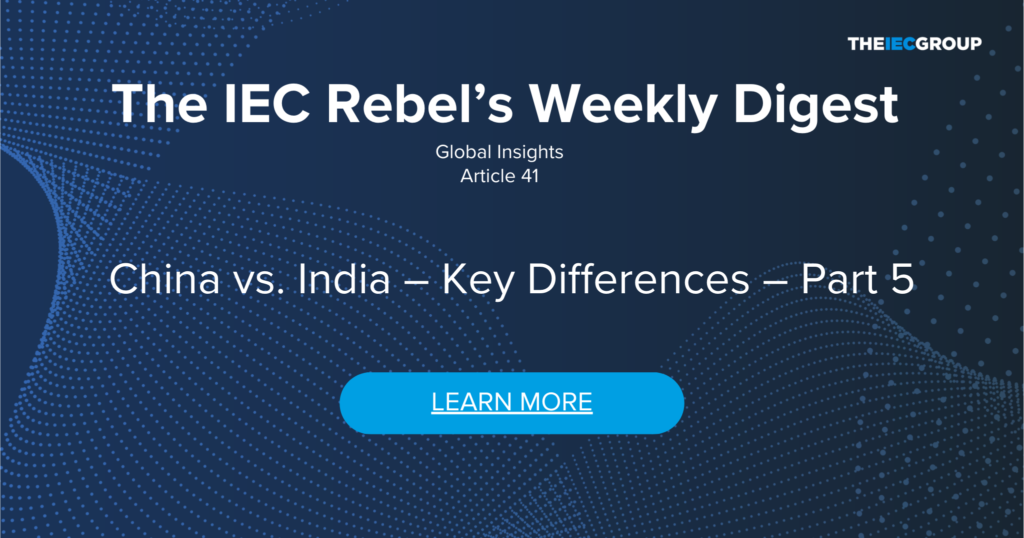China vs. India – Foreign Politics and Exchange
 China and India, the world’s two most populous nations, approach foreign policy, corporate activities, and global migration in distinctly different ways. China’s foreign policy is assertive, focused on expanding global influence through initiatives like the Belt and Road, and backed by state-driven corporate expansion. Chinese companies, often state-supported, aggressively pursue global markets but face regulatory challenges abroad. China also exports labor through large infrastructure projects and encourages talent to return home after gaining experience abroad.
China and India, the world’s two most populous nations, approach foreign policy, corporate activities, and global migration in distinctly different ways. China’s foreign policy is assertive, focused on expanding global influence through initiatives like the Belt and Road, and backed by state-driven corporate expansion. Chinese companies, often state-supported, aggressively pursue global markets but face regulatory challenges abroad. China also exports labor through large infrastructure projects and encourages talent to return home after gaining experience abroad.
In contrast, India’s foreign policy is more regionally focused, emphasizing multilateralism and democratic values. Indian companies excel in IT services, pharmaceuticals, and organic global growth, facing fewer regulatory hurdles but challenges in scaling. India’s diaspora is large, influential, and well-integrated globally, contributing significantly to host economies while maintaining strong ties to India. Understanding these differences is key to navigating the unique opportunities and challenges each country presents on the global stage.
China vs. India – Foreign Politics and Exchange
China and India have distinct approaches to foreign policy, corporate activities, and migration, each shaped by their unique histories, geopolitical ambitions, and economic strategies. Here’s a comparison of these aspects:
- Foreign Policy
- China:
- Global Influence: China’s foreign policy is characterized by assertive diplomacy aimed at expanding its influence globally. The Belt and Road Initiative (BRI) is a cornerstone of this strategy, seeking to enhance trade routes and infrastructure across Asia, Africa, and Europe.
- Bilateral Relations: China often engages in bilateral relationships that emphasize economic cooperation, with a focus on securing natural resources, expanding markets, and securing strategic footholds.
- Soft Power and Diplomacy: China is increasingly using soft power through cultural exchanges, Confucius Institutes, and media to shape global perceptions. However, its aggressive stance in the South China Sea and with neighbors like India and Japan has led to regional tensions.
- Geopolitical Strategy: China’s geopolitical strategy is marked by its focus on becoming a dominant global power, particularly through military modernization and technological leadership. Its relations with the U.S. are pivotal, involving both cooperation and significant rivalry.
- India:
- Global Influence: India’s foreign policy is more regionally focused, with a strong emphasis on South Asia and the Indian Ocean. However, India is increasingly seeking to enhance its global role through multilateral forums like the United Nations and BRICS.
- Bilateral Relations: India pursues strategic partnerships with major global powers, including the U.S., Russia, and the EU, while balancing relations with neighbors like China and Pakistan. It also engages in extensive development aid and technical assistance programs, particularly in Africa.
- Soft Power and Diplomacy: India leverages its cultural heritage, including Bollywood, yoga, and its diaspora, as tools of soft power. The country also emphasizes democratic values and non-alignment in its diplomatic engagements.
- Geopolitical Strategy: India’s geopolitical strategy involves balancing China’s influence in Asia through initiatives like the Quad (with the U.S., Japan, and Australia) and expanding its naval presence in the Indian Ocean. India’s approach is more cautious, focusing on building alliances and ensuring regional stability.
- Corporate Activities and Global Presence
- China:
- Global Expansion: Chinese companies, often state-owned or supported, are aggressively expanding abroad, particularly in Africa, Latin America, and Southeast Asia. Sectors like telecommunications (Huawei), technology (Alibaba, Tencent), and manufacturing are leading this expansion.
- Investment Strategy: China invests heavily in foreign infrastructure, natural resources, and technology through mergers, acquisitions, and joint ventures. The government provides significant backing to companies expanding overseas, often as part of the BRI.
- Regulatory Influence: Chinese companies often face scrutiny and regulatory challenges abroad, particularly in the U.S. and Europe, due to concerns about security, intellectual property, and government influence.
- Challenges: Despite their global reach, Chinese companies sometimes struggle with integration, cultural adaptation, and backlash against perceived government overreach in foreign markets.
- India:
- Global Expansion: Indian companies are increasingly making their mark abroad, particularly in IT services (TCS, Infosys), pharmaceuticals (Sun Pharma, Dr. Reddy’s), and automotive (Tata Motors). The focus is on expanding through service exports and global market penetration.
- Investment Strategy: India’s global investment strategy is less aggressive than China’s, with a focus on organic growth, strategic partnerships, and mergers in key sectors like technology, pharmaceuticals, and consumer goods.
- Regulatory Influence: Indian companies generally face fewer regulatory challenges abroad compared to Chinese firms, partly due to their democratic governance model and alignment with global norms.
- Challenges: Indian companies often face challenges related to scaling operations globally, brand recognition, and competing with larger multinational corporations from developed countries.
- People Working and Migrating Abroad
- China:
- Migration Patterns: Chinese migration abroad is significant, with a large diaspora in Southeast Asia, North America, and Europe. The government encourages talent to gain experience abroad, though it also promotes “talent return” initiatives to bring expertise back to China.
- Expatriate Workers: China exports labor through large infrastructure projects overseas, particularly in Africa and Asia. Chinese expatriates often work in state-backed projects, maintaining close ties to Chinese companies and government agencies.
- Education and Returnees: A significant number of Chinese students study abroad, particularly in the U.S., Europe, and Australia. There is a strong push for these students to return home with skills and knowledge to contribute to China’s development.
- Challenges: Chinese expatriates sometimes face challenges related to integration, language barriers, and perceptions of China’s political system in host countries.
- India:
- Migration Patterns: India has a large and influential diaspora, particularly in the U.S., the Middle East, and the UK. Indian migrants are often well-integrated, contributing significantly to their host countries’ economies, particularly in IT, healthcare, and academia.
- Expatriate Workers: Many Indians work in the Middle East, particularly in construction, engineering, and service industries. The Indian government actively engages with its diaspora, leveraging their influence for economic and political gains.
- Education and Returnees: Indian students also study abroad in large numbers, with many staying on to work in their host countries. However, India’s “brain drain” is a concern, though some initiatives encourage skilled professionals to return.
- Challenges: Indian expatriates often face issues related to visa restrictions, work permits, and adjusting to different cultural environments. However, the Indian diaspora generally enjoys a positive reputation globally.
Comparison Summary
- Foreign Policy: China’s foreign policy is more assertive and global, focused on expanding influence through infrastructure projects and strategic partnerships, while India’s approach is more regionally focused and cautious, emphasizing multilateralism and democratic values.
- Corporate Activities: Chinese companies are aggressively expanding globally, often backed by state support, but face significant regulatory scrutiny abroad. Indian companies focus on organic growth and strategic partnerships, with fewer regulatory hurdles but challenges in scaling.
- Migration and Expatriates: China’s expatriates are often linked to state-driven projects and face integration challenges, while India’s diaspora is well-established, influential, and generally well-integrated in host countries.
Conclusion
Understanding the differences between China and India in foreign policy, corporate activities, and migration is crucial for businesses, policymakers, and individuals. China’s assertive global strategies and state-backed corporate expansion contrast with India’s more cautious, democratic approach and the influential role of its diaspora. These differences shape each country’s global presence and the experiences of their citizens abroad.
Go To’s: After reading this, here are the key recommendations to consider:
- Assess Global Strategy: Evaluate how your business or organization can align with China’s assertive global strategies or India’s more regionally focused, democratic approach.
- Understand Regulatory Environments: If expanding globally, consider the regulatory challenges that Chinese companies face versus the smoother, but more cautious, path for Indian companies.
- Leverage Diaspora Networks: For those working with or within the Indian diaspora, leverage their influence and integration in host countries to expand business opportunities.
- Explore Partnerships: Consider forming strategic partnerships in China to navigate state-backed initiatives, or in India to tap into sectors like IT services and pharmaceuticals.
- Monitor Political Developments: Stay informed about geopolitical shifts in both countries to better anticipate and adapt to changes in foreign policy and market dynamics.
- Engage with Talent: If involved in education or recruitment, consider the opportunities for engaging Chinese and Indian talent, whether abroad or through initiatives encouraging their return home.
Introducing the IEC Knowledge Network Free Membership – Your Gateway to Seamless Access!
We are thrilled to present a new service that goes beyond the ordinary download experience. In addition to offering you the ability to download the things you love, we are delighted to introduce the IEC Knowledge Network Free Membership.
The Free Membership option grants you access to our library of articles and videos, without the need for tedious registrations for each piece of content.
The publication serves as a trusted resource to support executives in their pursuit of sustainable and successful global expansion. In addition the IEC Practitioners are available to discuss your specific challenge in more detail and to give you clear advise..
Take advantage of this valuable resource to accelerate your global expansion journey.
Introducing the IEC Knowledge Network Free Membership – Your Gateway to Seamless Access!
We are thrilled to present a new service that goes beyond the ordinary download experience. In addition to offering you the ability to download the things you love, we are delighted to introduce the IEC Knowledge Network Free Membership.
The Free Membership option grants you access to our library of articles and videos, without the need for tedious registrations for each piece of content.
The publication serves as a trusted resource to support executives in their pursuit of sustainable and successful global expansion. In addition the IEC Practitioners are available to discuss your specific challenge in more detail and to give you clear advise..
Take advantage of this valuable resource to accelerate your global expansion journey


